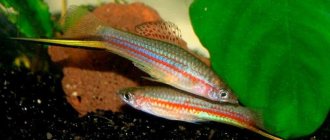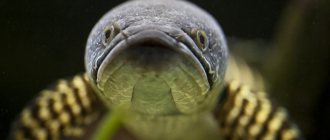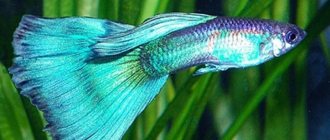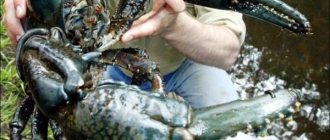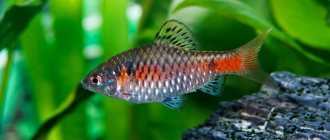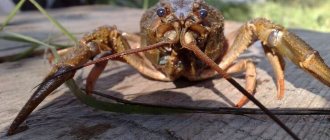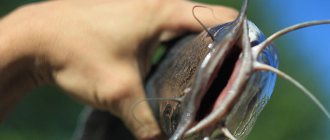Catfish
Simplicity of content:
Latin name: Platydoras costatus
Lifespan: 10-15 years
Maximum size: 25 cm.
Average cost: 300 rub.
An inhabitant of the river basins of South America, Platydoras striped has long been firmly established in the indoor reservoirs of Russian aquarists. The species of catfish of the armored family is distinguished by its curiosity, good nature, and unusual appearance.
Their unpretentiousness to the environment makes catfish attractive to beginning aquarium fish lovers.
Description
The outline of the body from above is similar to an arrow. Large head. Stiff mustache. Thick skin with spiked growths on the sides and fins. Hard occipital shield.
In nature, the size of catfish reaches 25 cm in length, in an aquarium it is 15-20 cm.
Appearance
Color ranges from brown to black with white and yellow stripes along the edges of the dorsal and ventral fins, head and sides. The coloring gave the breed its name - striped catfish.
Catfish fry are bright and striped. With age, the stripes fade and are not so noticeable.
View this post on Instagram
Big Boy's out! Pet since 15 years. . . . . . #catfish #pet #communitytank #fishkeeping #platydoras #platydorasarmatulus #nofilter #bigboy
A post shared by Aqscpr_eu (@aqspr_eu) on Sep 6, 2021 at 8:50am PDT
Behavior
They lead a nocturnal, bottom-dwelling lifestyle. Rarely rise to the surface. They love to dig in the ground. Young platidoras clean large fish of parasites and dead scales. Peaceful and calm towards their neighbors.
Platidoras received the name singing catfish for its ability to make vibrating or chirping sounds to attract a female or in moments of danger.
Lifespan
Wild striped lives up to 20 years, aquarium up to 15.
Kinds
Striped platidoras
Initially, the striped catfish was called Platydoras costatus, but about 12 years ago a group of biologists created a classification of species by habitat. Based on this, the species includes catfish that live in rivers in eastern South America.
Raphael's striped catfish
Platydoras, which is distributed throughout the country, is called Raphael's striped catfish. This type has been available in stores for many years and is the most well known.
Platidoras brachylesis
This species is found in the rivers of northeastern Brazil. It is distinguished by a light yellow line along the body, which runs strictly in the center, from the head to the end of the caudal fin; the rays of the remaining fins are also colored yellow. The area on the side behind the pectoral fins is darkened.
Content
Singing catfish spend most of their time at the bottom. Adapt to smooth changes in water. They prefer a dimly lit aquarium with plenty of hiding places, vegetation and snags.
Aquarium
Aquarium size from 120 liters. Platidoras leads a bottom-dwelling lifestyle, so vessels (aquariums) that are too high with a small bottom area are not suitable. Needed with a large bottom area. The best option is a rectangular container 40-50 cm high.
Water parameters
When keeping platidoras, maintain natural water parameters within the following limits:
- hardness – 1-1.5 dH;
- acidity – 6-7.5 pH;
- water temperature – 25-30 degrees.
Most of the individuals sold in pet stores are raised in artificial conditions. Such catfish are adapted to exceeding the hardness and acidity of water, and also easily tolerate short-term drops in temperature. But the water should only be fresh. Change 30% of the water once a week.
Plants
Aquarium striped catfish do not harm large plants, eating only the smallest algae. Nocturnal inhabitants raise silt from the bottom, which can lead to the formation of plaque on thin leaves.
Plenty of vegetation is essential for Platydoras to thrive, but be sure to leave plenty of room for swimming. It is preferable to have plants floating on the surface that can shade the bottom. For example, elodea and hornwort.
Priming
When decorating the bottom, install driftwood, clay pots, and cut plastic pipes that platidoras can use as shelter.
Include sand and fine gravel in the soil, as catfish like to burrow.
Equipment
The striped catfish's natural habitat is swampy streams and rivers.
The unpretentious Platydoras catfish feels comfortable in the presence of a slight current, enhanced aeration and moderate filtration. The saturation of water with oxygen is important for the health of the inhabitants of the aquarium.
Lighting
Striped animals do not feel comfortable in too bright light and prefer shaded areas. If you want to watch the fish at night, set the backlight to dim.
Feeding
In nature, catfish find food at the bottom. The diet includes shellfish, crustaceans, and organic products.
In the aquarium it feeds on sinking food:
- live and frozen tubifex, bloodworms, worms;
- finely chopped fish;
- industrial feed;
- grated cucumber, lettuce, zucchini.
Platydoras is not picky when it comes to nutrition. When choosing food, maintain a 4:1 ratio of protein to plant foods.
Follow your diet. Give food once every day in the evening. Calculate your serving size carefully. If the fish become noticeably fatter, stop feeding the platidoras for a couple of days.
Compatibility
Platydoras striped catfish is peaceful and friendly. Shows high compatibility with other inhabitants of the aquarium.
View this post on Instagram
#fishtank #fish #goldfishes #goldfish #carassiusauratus #hoplosternum #hoplo #hoplosternumthoracatum #thoracatum #ghostfish #knifefish #pleco #plecostomus #sharkfish #balashark #blackghostknifefish #balantiocheilosmelanopterus #blackghost #apteronotusalbifrons #blackmoor #blackmoorgoldfish #hypostomus
A post shared by Animalu Vali (@animalu_vali) on Jul 7, 2021 at 3:40am PDT
Gets along with fish without a heightened sense of territoriality of medium and large size:
- cichlids;
- tetras;
- carp;
- angelfish;
- goldfish;
- gourami.
Choose medium and large breeds. The striped catfish takes snails, shrimp and small fish for food:
- guppy;
- neon.
If the neighbors are aggressive, it rarely appears on the surface.
In wild waters, platidoras create flocks for safety and food production. Aquarium striped catfish can be aggressive with each other during the period of habituation. Over time, the fights stop and the fish share shelter and food.
Habitat
Platidoras catfish lives in South America, Brazil, Bolivia, Colombia, Peru, and Venezuela. For its residence it chooses bodies of water with slow flow or standing water. Fish build shelters for themselves among the flooded roots or thickets of aquatic plants.
Platidoras likes to hide in sandy soil if they sense danger from the outside. Catfish can gather in schools to counteract the threat posed by predators.
Thanks to the ability to raise singing catfish on special farms, these unique fish can be purchased at the store and placed in a home aquarium.
Reproduction
Catfish are propagated using hormonal injections on specialized farms. There are isolated cases of breeding when in captivity fish reproduced on their own and aquarists found fry that had already hatched.
Sex differences
Sexual deformity in this breed is not pronounced. The male is slimmer and brighter than the female. When purchasing, consult a professional aquarist.
Spawning
In nature, Platydoras females use streams and rivers for spawning. They build nests from leaves, branches and small pieces of wood, or use snags and fallen trees. Females hide in the created shelter and lay eggs. Males swim around the nest several times in a circle. On average, a female lays about 300 eggs at a time. The fry hatch after 3 days, and after 5 they are capable of feeding on their own.
Breeding
Puberty in Platidoras occurs in the second year of life. Natural reproduction in an aquarium is difficult; hormonal injections are used.
Producers are placed in a separate tank filled with soft (6-7 °dH) water to a height of 20 cm, heated to a temperature of +27...+30 °C. Shelters are installed on the bottom and floating vegetation (riccia) is added so that the catfish can create a nest for eggs. After laying, the fish are immediately removed so that they do not eat the offspring. It is recommended to catch them in plastic containers due to the presence of a large number of spines.
The incubation period lasts three days, then the fry are born. After two days they adapt, begin to swim and eat food.
Diseases
Platydoras catfish are susceptible to viral infections, parasites and fungal diseases. But by nature the fish is hardy.
- Be careful when planning your diet. Fish get sick and die due to a lack of necessary substances or an excess of food.
- Thoroughly clean new items and plants, and quarantine newly purchased fish before transplanting them into the main container.
- Monitor your nitrate levels. Strong excess is the optimal environment for the development of whisker infections. Constantly replacing part of the water will help avoid this.
- Do not feed your fish more food than they can eat, otherwise decaying organic matter will pollute the water, causing fin necrosis.
- Platydoras have spines on their bodies; if you try to catch them with a net, injuries are inevitable. Use a thick canvas net for transplanting purposes.
- Do not treat sick catfish with potassium permanganate or copper-containing substances, this will lead to death.
Reviews
Owners note the omnivorous nature, ability to make sounds, and friendliness of the fish.
Diseases and prevention
Striped catfish, like other aquarium fish, are susceptible to diseases resulting from improper care. Due to the lack of scales, they are treated with drugs: Pimafix or Melafix. Potassium permanganate and other medications containing copper will have a negative effect.
Platydoras have sharp spines and can be damaged when moving when entangled in nets. The whiskers, with the help of which the catfish obtains food for itself and orients itself in space, are harmed by the high content of nitrates in the water. To reduce it, it recommends weekly water changes and maintaining the level of the hazardous substance within 20 ppm.
Adviсe
- Platydoras is not aggressive. It is friendly to its neighbors, but may harbor fry, eggs and crustaceans. Choose medium to large sized fish.
- Neon lighting will not disturb residents and will allow you to observe their lives.
- Do not overfeed your pets. They have no sense of proportion.
- Use quality sinking feed and store it in vacuum packaging.
- Catfish live in stagnant bodies of water or with weak currents, so filtration should be moderate.
Platidoras is suitable for aquarists of any level. Easy care and infrequent feeding make it an ideal pet for busy people or office aquariums.
Previous
Fish Why are bettas called betta fish?
Next
Fish14 popular viviparous aquarium fish
Reviews
The aquarium catfish is of particular interest for study. He has a very original demeanor and is easy to care for. To prevent illnesses from overtaking it, it is recommended to provide the aquatic inhabitant with good aquarium conditions and comply with the required regulations. And a long-lived pet will delight its owner with its presence.
Did you like the singing catfish? Share in the comments!
